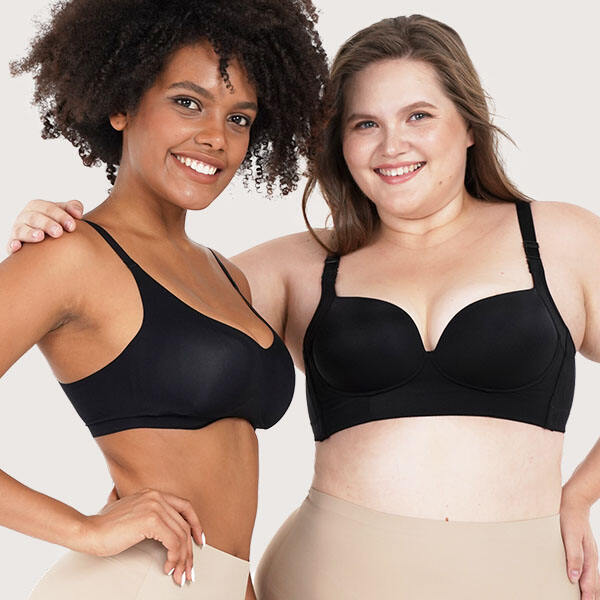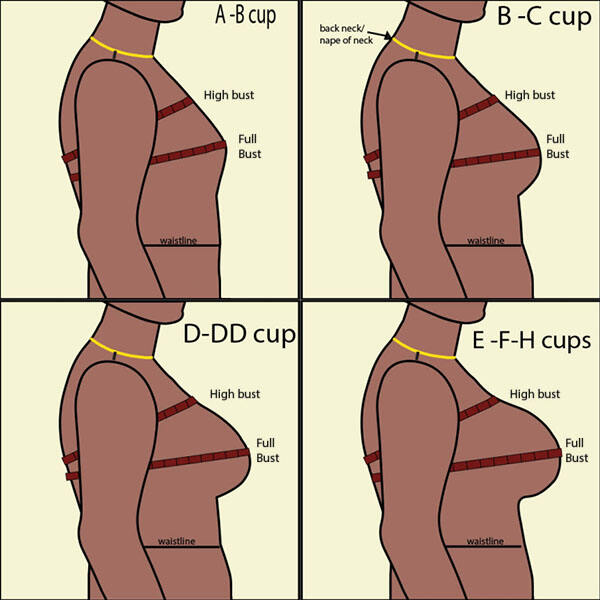BLOG


· Comparing Cup Sizes: A vs. B Cup
· Comparing Cup Sizes: B vs. C Cup
· Comparing Cup Sizes: C vs. D Cup
· Band Size – The number (like 32, 36, 40). This measures the circumference of your ribcage, just under the bust.
· Cup Size – The letter (A, B, C, D, etc.). This reflects the volume of your breasts, based on the difference between your bust measurement (the fullest part of your chest) and your band size.

· A Cup = 1-inch difference between bust and band measurements
· B Cup = 2-inch difference
· C Cup = 3-inch difference
· D Cup = 4-inch difference
· DD/E (5-inch difference), DDD/F (6-inch difference), and so on. Brands may use slightly different naming conventions, especially in the UK and Europe.
Inch Difference |
Cup Size |
Note |
1 |
A Cup |
Small bust, subtle curve |
2 |
B Cup |
Medium bust, natural look |
3 |
C Cup |
Full bust, rounded silhouette |
4 |
D Cup |
Full/large bust, more support |
5+ |
DD/E+ |
Extra support, specialized fit |
· A 36B is not the same as a 34B. Although both have a “B” cup, the actual volume of a B cup gets larger as the band size increases.
· This is why “sister sizes” exist: cup sizes are not absolute—they’re relative to band size.
· AA or AAA (smaller than A), common for petite or very small busts
· DD, E, F and beyond (larger/full bust bras), essential for adequate support and comfort
· European/UK Sizes — Sometimes include E, F, G, H, etc.
Letter |
US/UK Equivalent |
Notes |
A |
A |
Small bust |
B |
B |
Common medium bust |
C |
C |
Average to full bust (globally) |
D |
D |
Full bust/needs more support |
DD/E |
DD (US), E (UK/EU) |
Larger bust/supportive bras needed |
F |
DDD/F (US), F (UK) |
Large bust, specialty sizes |

· Find a Soft Measuring Tape: If you don’t have a tailor’s tape, use a long piece of string and then measure it with a ruler.
· Wrap the Tape Snugly Around Your Ribcage: Stand up straight, breathe normally, and wrap the tape measure around your underbust circumference—directly underneath your breasts.
· Make Sure the Tape Is Level: It should be straight all the way around and snug, but not pressing into your skin.
· Take the Measurement in Inches: Round to the nearest whole number. If the number is even, add four inches; if odd, add five. For example, if your underbust circumference is 31, add five for a band size of 36.
· Wear a Lightly Lined Bra: Avoid padding, which can skew results. If you’re measuring yourself at home, stand in front of a mirror for accuracy.
· Wrap the Tape Measure Around the Fullest Part of Your Bust: Usually at nipple level. The tape should be level and comfortably snug—not loose, but not compressing the breasts. Breathe out and relax for the truest measurement.
· Record This Number in Inches.
Bust – Band (inches) |
Cup Size |
1 |
A |
2 |
B |
3 |
C |
4 |
D |
5 |
DD/E |
6 |
DDD/F |
7+ |
G (and beyond)* |
· 36 (bust) – 34 (band) = 2
· 2-inch difference = B cup
· Your bra size is likely 34B
· Measure at the end of the day, when your body is at its least compressed.
· Always stand straight with your arms relaxed at your sides.
· Double-check your measurements for accuracy—mistakes often result from not keeping the tape straight and level.
· Don’t pull the tape measure too tight; it should not dig in or leave marks.
· Using a padded or push-up bra during measurement, which inflates the bust size.
· Not keeping the tape level with the floor: it rides up at the back, adding inches.
· Rounding up or down excessively—always use the closest full inch.
· Assuming cup sizes are the same across all bands (remember: a 32D cup ≠ 38D cup in cup volume).
Actual Band (inches) |
Additions |
Your Band Size |
Bust (inches) |
Bust – Band |
US Cup Size |
Final Bra Size Example |
29 |
+5 |
34 |
36 |
2 |
B |
34B |
31 |
+5 |
36 |
39 |
3 |
C |
36C |
34 |
+4 |
38 |
42 |
4 |
D |
38D |
36 |
+4 |
40 |
45 |
5 |
DD/E |
40DD |
· Brand Variations: Fabric stretch, cup depth, bra style (demi vs. full coverage), and even country of manufacture can all alter the actual fit.
· Fashion vs. Functional Sizing: Some brands “vanity size” their bras for a more generous fit; others stick to traditional measurements.
· Great for petite builds or those preferring subtle shaping.
· Consider seamless bras or everyday bralettes for comfort.
· Choose supportive bras with a bit more structure.
· Wireless bras are often comfortable for B cup and C cup wearers.
· Full coverage and shaping bras give optimal support.
· Sports bras for larger busts with firm bands and wide straps are ideal for active lifestyles.
· Correct support helps prevent back, neck, and shoulder pain, especially for those with fuller cup sizes (like C or D cups).
· Bras that fit well also reduce “digging in,” slipping straps, and uncomfortable pressure that can distract you from your day.
· An ill-fitting bra, particularly for larger busts, can alter your posture, leading to chronic pain or even nerve issues.
· According to studies by the University of Portsmouth, incorrect bra support can negatively impact spinal health over time.
· The right cup and band size underpins everything you wear—from seamless t-shirts to elegant dresses.
· A perfect fit creates smooth lines, provides breast shaping, and gives a natural, lifted look.
· Wearing the right size bras and caring for them properly means they last longer—saving money and reducing waste.
· No gaps or overflow in the cup
· Band sits snugly (not too tight, not riding up)
· Straps stay in place without digging
· You feel comfortable (no itching, pinching, or needing to adjust)
Problem |
Possible Bra Fit Mistake |
Solution |
Straps slip off shoulders |
Band too big or cup too small |
Adjust straps, try smaller band |
Spillage or "double boob" |
Cup too small, wrong style for bust shape |
Size up a cup or try a new style |
Band rides up your back |
Band too large |
Decrease band size |
Cups "float" or gap |
Cup too large; not enough breast tissue |
Downsize the cup or try a demi |
 Hot News
Hot News2025-09-16
2025-09-17
2025-09-18
2025-09-19
2025-08-24
2025-08-25